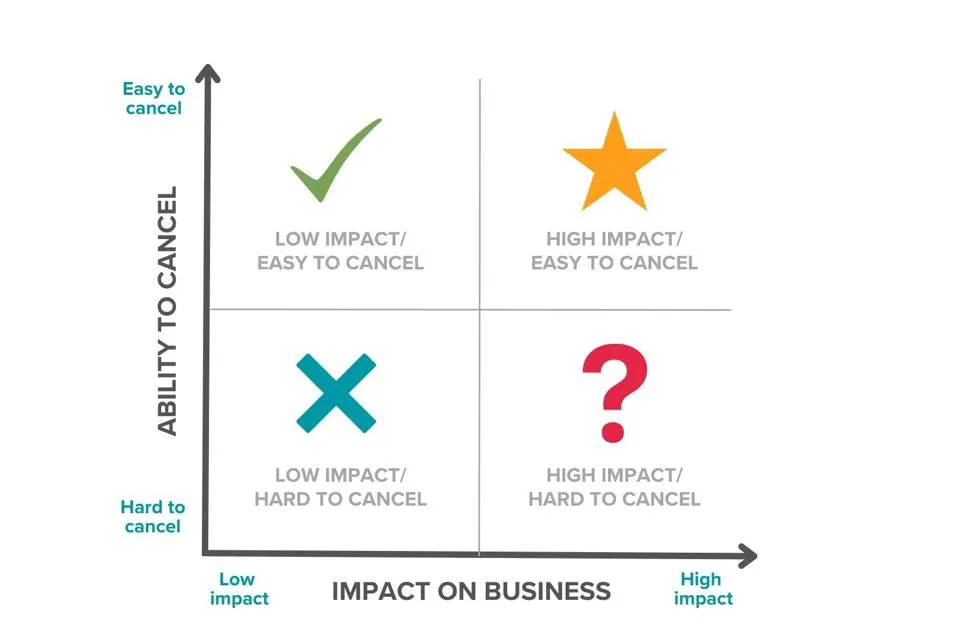
Erika Ayers Badan: What Do You Want?
Please meet Cynthia Pong. She came to me by way of super-connector and personal board director an occasional SVU actor, Sarah Storm. Cynthia Pong packs…
Thought Leader: Erika Ayers Badan

If you could eliminate any workplace rule that frustrates you or slows down your team’s productivity, what would it be and why? When I directed that question to teams at AT&T, they responded with a list of 459 annoying rules to change or cancel. Much to everyone’s shock, leadership actually acted to eliminate or modify all of them.
Canceling annoying rules is one of many anti-complexity measures taken by AT&T that have resulted in an annual savings of $186M. It’s also a fantastic starting place if you’ve noticed complexity creeping into your operations. The technique can be led in-person, remotely or hybrid and requires either virtual or physical sticky notes as well as a whiteboard.
Ahead of your session, draw a matrix on the virtual or physical whiteboard and label the vertical axis with “Ability to Cancel” and the horizontal axis with “Impact on Business.” The four quadrants should be equal and labeled according to the illustration below.

After gathering your teams, give everyone 30 minutes to identify as many annoying rules as possible. Direct them to focus on rules that are directly related to their sphere of control and business unit — not the larger organization. Examples range from “four approvals are required for one hire” and “expense reports are mandatory for $5 purchases” to “Internet use is restricted or forbidden” and “ban on ChatGPT usage.”
Also, encourage people to think in terms of red rules versus green rules. Red rules are government-mandated and industry-regulated. You’ll go to jail if you cancel those rules, so leave them as is. Everything else is a green rule and fair game.
Write or type each annoying rule on a physical or virtual sticky note and place it on the matrix, according to how easy it is to cancel and how much impact its elimination will have on the business. For example, if someone believes a rule is low impact and hard to cancel, it should be placed in the lower left quadrant. If it’s high impact and easy to cancel, plot it in the top right.
While there’s no right or wrong placement of rules, I find that participants typically cluster rules in the top half of the grid — with the majority in the upper right quadrant. Few rules will likely be placed in the lower left quadrant (low impact/hard to cancel) so if a cluster of rules starts forming in the upper right, lead a discussion about what people perceive as real-world impact or ease of implementation.
As the facilitator, scan the matrix for prime targets: rules that will have a high impact once they’re canceled and don’t require permission from anyone else to kill. If you’re not certain if you have authority to kill the rule, suspend it for a few weeks or months. If no one misses it and there’s no adverse effects, get rid of it permanently. Also, take note when multiple employees or teams nominate the same rule for cancellation since this indicates a barrier to productivity across your org.
After 30 minutes, ask the group to vote on which rule should be canceled. Then do it, right on the spot. If possible, kill five rules. By leading tens of thousands of people through this exercise, I’ve found that most annoying rules aren’t actually rules — they’re just frustrating processes that we assume are rules. Many were created by leaders who aren’t even with the company anymore, so be sure to clear up misperceptions around rules on the matrix that aren’t formal policy.
While rules are necessary to keep operations running smoothly and within legal limits, excessive rules slow down productivity and breed a repressive environment. Canceling annoying rules offers a structured framework and safe environment for people to question the status quo. Encourage employees to question any process without purpose —and reward those who find ways to simplify their daily work beyond rule-canceling sessions.
Erika Ayers Badan: What Do You Want?
Please meet Cynthia Pong. She came to me by way of super-connector and personal board director an occasional SVU actor, Sarah Storm. Cynthia Pong packs…
Thought Leader: Erika Ayers Badan
Patrick McGee: Foreign Affairs Best Books of 2025
McGee, a Financial Times journalist, brings his investigative skills to bear on the fascinating history of how, over a quarter century, China and the technology…
Thought Leader: Patrick McGee
Dr. Sanjay Gupta: How to Identify Medical Misinformation
As a practicing neurosurgeon and CNN’s chief medical correspondent, Dr. Sanjay Gupta can spot false health claims from a mile away. Still, he recently became…
Thought Leader: Sanjay Gupta

